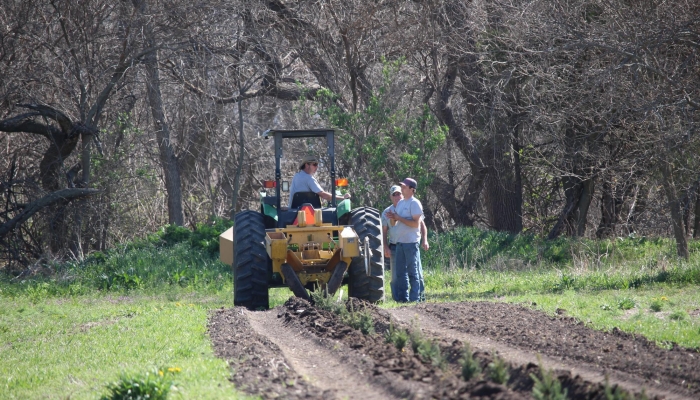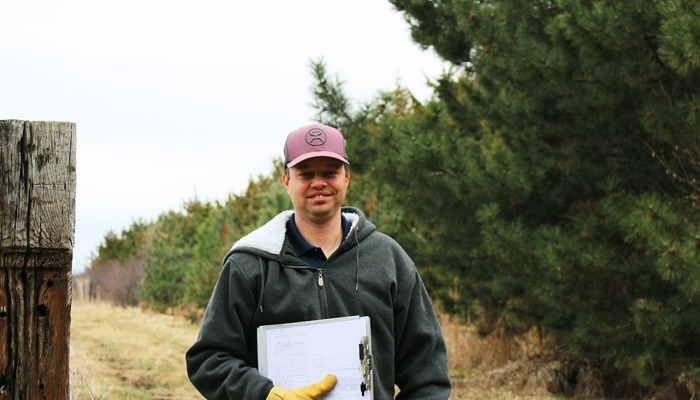Nebraska’s NRDs Plant 100 Millionth Tree
Note 4/19: If you ordered trees through the Upper Big Blue Natural Resources District, you will be contacted very soon about when and where your trees will be available for pick up. You can also check for updates on our social channels or on www.upperbigblue.org/trees.
LINCOLN, Nebraska – Since their inception in 1972, Nebraska’s Natural Resources Districts (NRDs) have been planting conservation trees and shrubs for windbreaks, erosion control, wildlife habitat and other conservation purposes. This spring, the NRD Conservation Tree Program plants their 100 millionth tree – that’s approximately 50 trees for each Nebraskan.
“Nebraska has a proud history of planting trees, and putting the 100 millionth tree in the ground reflects Nebraskans’ willingness to invest in the future,” said Dr. Orval Gigstad, Nebraska Association of Resources Districts president. “Our tree planting success is owed to the forward-thinking vision of landowners.”
Each year, the NRD Conservation Tree Program provides hundreds of thousands of low-cost, bulk trees for planting across the state. Districts collect orders for trees between November and March, then trees are distributed in April in time for spring planting. A majority of NRD conservation trees are sourced from the U.S. Forest Service’s Bessey Nursery in Halsey, Nebraska.
Gigstad noted that extreme weather events, diseases and invasive insects have impacted Nebraska’s tree population, but recent public-private partnerships demonstrate Nebraska’s tree planting spirit.
According to recent data released by the U.S. Forest Service, Nebraska’s trees and forests are experiencing steady declines. However, a newly formed partnership to reverse this trend has gained significant momentum with the announcement of a $4.3 million grant from the U.S. Department of Agriculture’s Natural Resources Conservation Service.
The Nebraska Forest Restoration Partnership brings together the Nebraska Forest Service, the state’s NRDs and the Nebraska Game and Parks Commission to address declines in the state’s forests and windbreaks. Using the award, partners will work directly with landowners to increase the scale and pace of forest restoration statewide. This includes planting 1.5 million trees, providing new management of 30,000 acres of declining forests, increasing the health and resiliency of 7,000 acres of vulnerable forests and restoring 250 linear miles of agricultural windbreaks.
In December, Executive Travel also announced a partnership with Nebraska’s NRDs to plant 1 million trees over the next five years through the ETGreen campaign, starting with 50,000 trees in 2022. This partnership gives Executive Travel the opportunity to assist local landowners in planting all 1 million trees in Nebraska.
“When Executive Travel was building the ETGreen initiative, we wanted to partner with a local organization dedicated to a sustainable future and a beautiful Nebraska,” said Steve Glenn, Executive Travel chairman. “This great network of local landowners who plant hundreds of thousands of trees through the NRD annually guarantees trees are planted and cared for.”
Each NRD program varies, but possible tree program services include planting, weed barrier installation or weed control, and drip irrigation. For more information on cost share availability, designing a plan or ordering trees, contact your local NRD or visit www.nrdtrees.org.
Natural Resources Districts’ staff and directors will plant the ceremonious 100 millionth tree on the Nebraska Capitol grounds in a public ceremony this fall.
Throughout 2022, the NRDs will commemorate breakthroughs and achievements in conservation. To join in the celebration and follow the Natural Resources Districts’ special activities throughout 2022, visit nrdnet.org and follow #Since1972 on social media.
The Nebraska Association of Resources Districts (NARD), the trade association for Nebraska's 23 Natural Resources Districts (NRD), works with individual districts to protect lives, property and the future of Nebraska’s natural resources. NRDs are unique to Nebraska, and act as local government entities with broad responsibilities to protect Nebraska’s natural resources. Major Nebraska river basins form the boundaries of the 23 NRDs, enabling districts to respond to local conservation and resource management needs. Learn more about Nebraska’s NRDs at www.nrdnet.org.
LINCOLN, Nebraska – Since their inception in 1972, Nebraska’s Natural Resources Districts (NRDs) have been planting conservation trees and shrubs for windbreaks, erosion control, wildlife habitat and other conservation purposes. This spring, the NRD Conservation Tree Program plants their 100 millionth tree – that’s approximately 50 trees for each Nebraskan.
“Nebraska has a proud history of planting trees, and putting the 100 millionth tree in the ground reflects Nebraskans’ willingness to invest in the future,” said Dr. Orval Gigstad, Nebraska Association of Resources Districts president. “Our tree planting success is owed to the forward-thinking vision of landowners.”
Each year, the NRD Conservation Tree Program provides hundreds of thousands of low-cost, bulk trees for planting across the state. Districts collect orders for trees between November and March, then trees are distributed in April in time for spring planting. A majority of NRD conservation trees are sourced from the U.S. Forest Service’s Bessey Nursery in Halsey, Nebraska.
Gigstad noted that extreme weather events, diseases and invasive insects have impacted Nebraska’s tree population, but recent public-private partnerships demonstrate Nebraska’s tree planting spirit.
According to recent data released by the U.S. Forest Service, Nebraska’s trees and forests are experiencing steady declines. However, a newly formed partnership to reverse this trend has gained significant momentum with the announcement of a $4.3 million grant from the U.S. Department of Agriculture’s Natural Resources Conservation Service.
The Nebraska Forest Restoration Partnership brings together the Nebraska Forest Service, the state’s NRDs and the Nebraska Game and Parks Commission to address declines in the state’s forests and windbreaks. Using the award, partners will work directly with landowners to increase the scale and pace of forest restoration statewide. This includes planting 1.5 million trees, providing new management of 30,000 acres of declining forests, increasing the health and resiliency of 7,000 acres of vulnerable forests and restoring 250 linear miles of agricultural windbreaks.
In December, Executive Travel also announced a partnership with Nebraska’s NRDs to plant 1 million trees over the next five years through the ETGreen campaign, starting with 50,000 trees in 2022. This partnership gives Executive Travel the opportunity to assist local landowners in planting all 1 million trees in Nebraska.
“When Executive Travel was building the ETGreen initiative, we wanted to partner with a local organization dedicated to a sustainable future and a beautiful Nebraska,” said Steve Glenn, Executive Travel chairman. “This great network of local landowners who plant hundreds of thousands of trees through the NRD annually guarantees trees are planted and cared for.”
Each NRD program varies, but possible tree program services include planting, weed barrier installation or weed control, and drip irrigation. For more information on cost share availability, designing a plan or ordering trees, contact your local NRD or visit www.nrdtrees.org.
Natural Resources Districts’ staff and directors will plant the ceremonious 100 millionth tree on the Nebraska Capitol grounds in a public ceremony this fall.
Throughout 2022, the NRDs will commemorate breakthroughs and achievements in conservation. To join in the celebration and follow the Natural Resources Districts’ special activities throughout 2022, visit nrdnet.org and follow #Since1972 on social media.
The Nebraska Association of Resources Districts (NARD), the trade association for Nebraska's 23 Natural Resources Districts (NRD), works with individual districts to protect lives, property and the future of Nebraska’s natural resources. NRDs are unique to Nebraska, and act as local government entities with broad responsibilities to protect Nebraska’s natural resources. Major Nebraska river basins form the boundaries of the 23 NRDs, enabling districts to respond to local conservation and resource management needs. Learn more about Nebraska’s NRDs at www.nrdnet.org.


